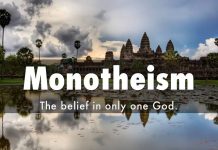Click here for previous session
Christians, as I once did, boast about the Gospels
According to Matthew, According to Mark,
According to Luke and According to John.
However, if we think about it, there is not a single
Gospel according to Jesus himself. 1o According to
the preface of the KJV New Open Bible Study
Edition, the word “Gospel” was added (see the
information below) to the original titles,
“According to John, According to Matthew,
According to Luke and According to Mark.”
At an early date this gospel was given the title Kata
Matthaion, “According to Matthew.” As this title
suggests, other gospel accounts were known at that
time (the word gospel was added later).4
The permission to call the “According to ”
writings the Gospel was not given by Jesus nor by
any other divine guidance. These writings;
Matthew, Luke, Mark and John were never
originally intended to be the Gospel. Therefore,
Mark 1: 1 can not be a true statement that his
writing is the gospel of Jesus.
It should be mentioned that Muslims must believe
in all Divine Scriptures in their original fonn, their
Prophets and make no distinction between them:
The Suhuf (Abraham); Torah (Moses); Psalms
(David); Gospel – or the Injeel (Jesus); and, the
Quran (Mohammed). It is clearly stated in the
Quran 3:3 that Allah sent down the Torah and the
Gospel. ,However, none of these scriptures remains
in its original form now, except the Quran, which
was sent for all mankind everywhere and for all
times.
In addition to other reasons why the Quran was
sent to mankind, as mentioned in 18:4-5, it was
sent to warn the Christians of a terrible
punishment from God if they cease not in saying:
“Allah hath begotten a son. ”
Muslims sincerely believe that everything Jesus
(May the peace and blessing of God be upon him)
preached was from God; the Gospel (Injeel): The
“good news” and the guidance of God for the
Children of Israel. 10 There is no place mentioned in
the present four Gospels that Jesus wrote a single
word of his Gospel, nor is it mentioned that Jesus
instructed anyone to do so. What passes off as the
“Gospels” today are the works of third party
human hands. 10
The Quran 2:79 says:
“And woe to those who write the book with their
own hands and then say: “This is from Allah
(God).” To traffic with it for a miserable price!
So woe to them for what their hands do write,
and woe to them for what they earn thereby!”
Before closing this chapter, I would like to share
with you some comments from an article printed in
the U.S. News & World Report, In Search of
Jesus, April 8, 1996, page 47-53:
• Robert Funk, a renowned biblical scholar, and
50 religion professors concluded that no more
than 20 percent of the sayings and even fewer
of the deeds attributed to Jesus are authentic.
Among the cast offs: the Lord’s Prayer, the
saying from the cross and any claims of Jesus
to divinity, the virgin birth, most of his
miracles and his bodily resurrection. (Page 49)
• John Meier, a professor at the Catholic
University of America in Washington DC:,
concludes:
* He (Jesus) was born around 7 BC in Nazareth, not
in Bethlehem as the gospel of Luke says.
* Despite official Catholic teaching that Mary, the
mother of Jesus, remained a virgin all of her life,
Meier says Jesus had four brothers and at least two
sisters, details that emerge from the gospels of Mark
and John and from the writings of Paul. The virgin
birth of Jesus, says Meier, “cannot be proven or
disproven” by historical investigation.
* He had a brief ministry in Galilee as a teacher,
prophet and worker of deeds that were perceived by
some as miracles.
* He was arrested in Jerusalem and crucified under
fontius Pilate somewhere around A.D. 30. His
followers claimed he rose from the dead. (Page 50)
• John Crossan, one of the most prolific of the
modem questers, a former Roman Catholic
priest and professor emeritus at Depaul
University in Chicago, thinks the evidence he’s
gathered would rule out most of Christianity’s
traditional teachings. Biblical accounts of the
Last Supper and appearances of the risen Jesus,
he says for example, are merely attempts by his
devout followers to express their “continued
experience” of his presence after the
Crucifixion. (Page 52)







